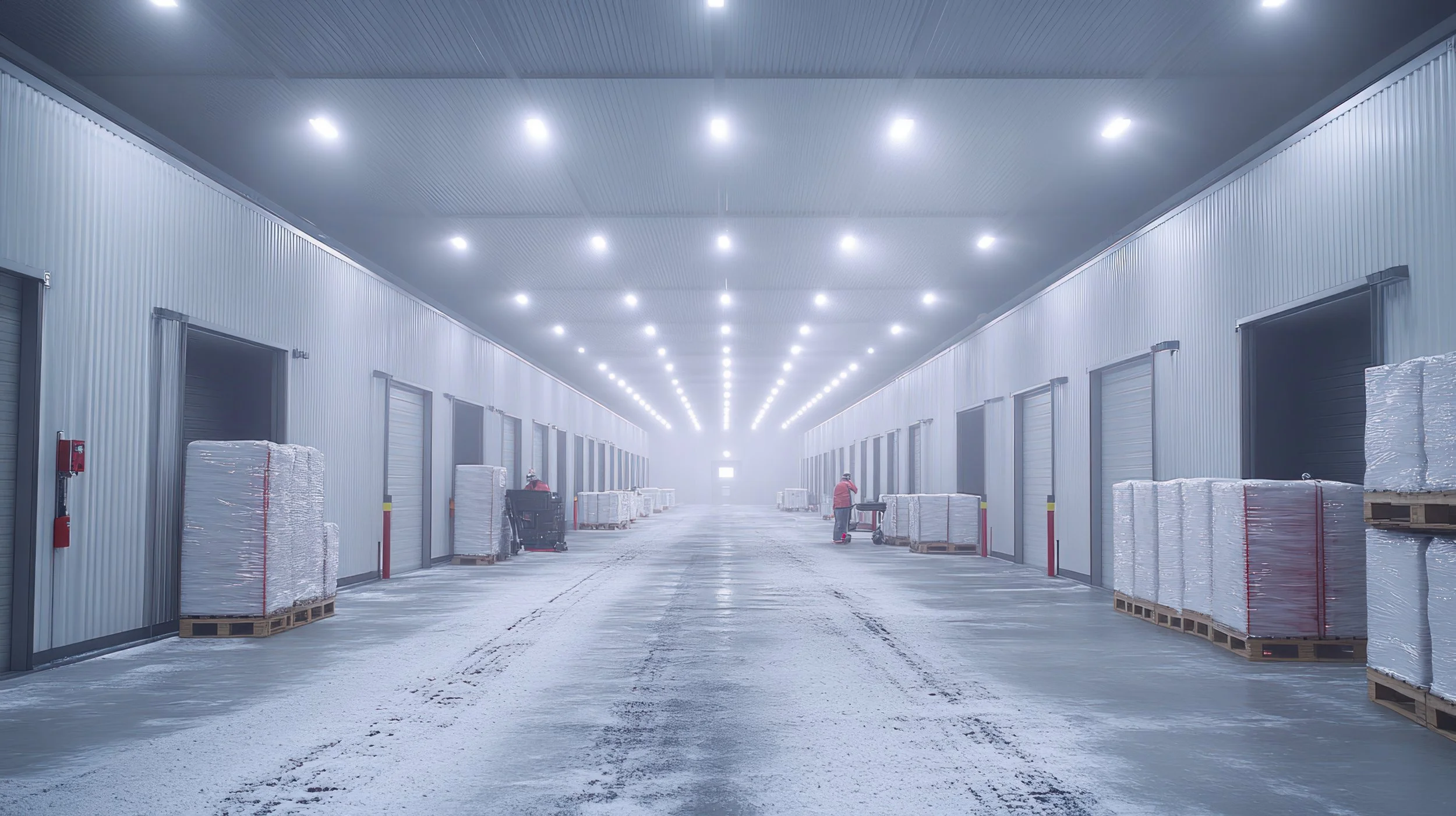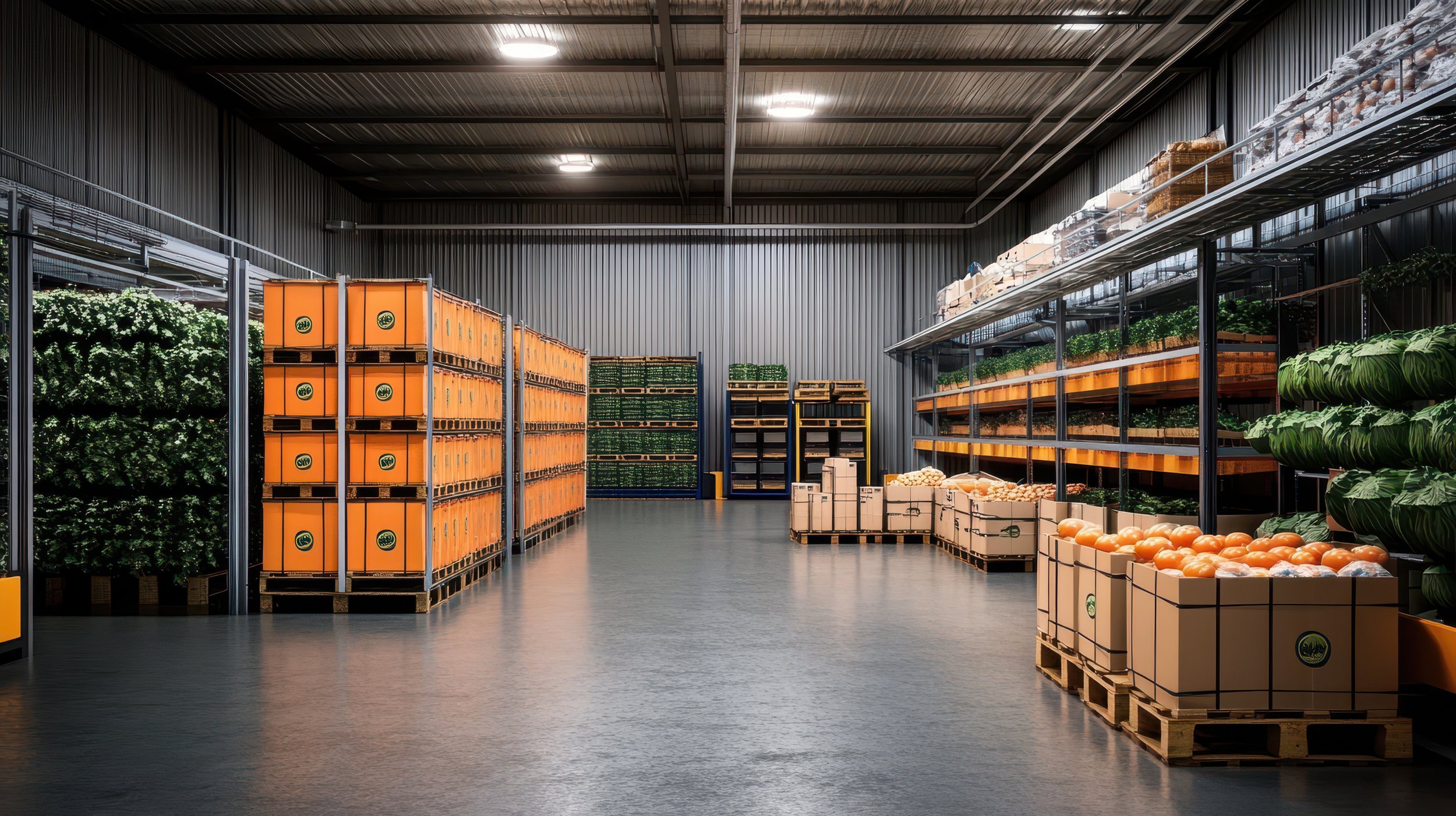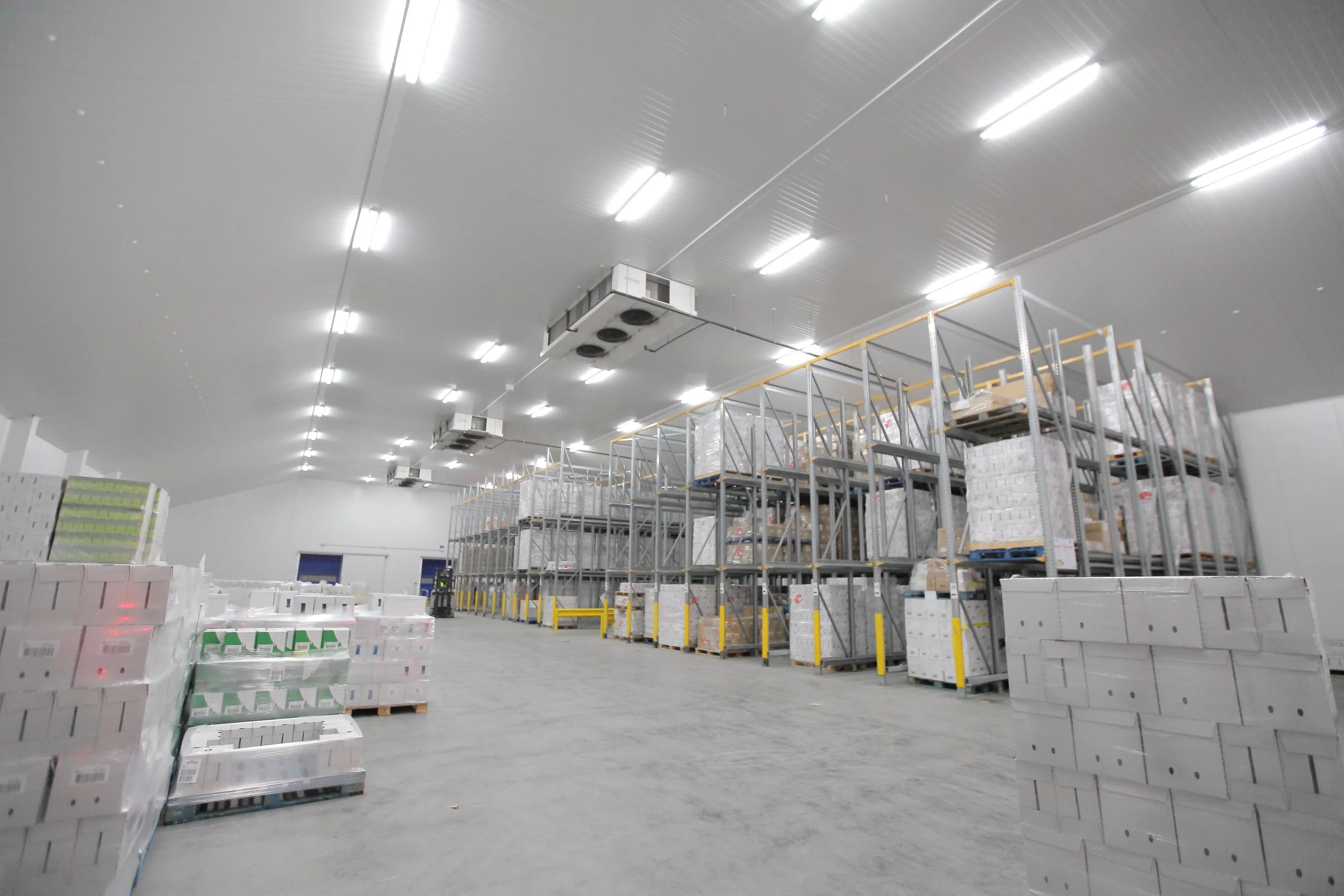Best Practices in the Construction of Cold Storage Facilities
Looking to build a cold storage facility? This article outlines the essential steps, including the construction of cold storage, planning, design, compliance, and best practices, to help you succeed.
Key Takeaways
The demand for cold storage facilities is driven by e-commerce growth, pharmaceutical needs, and rising imports in emerging markets, necessitating efficient design and construction.
Comprehensive planning and market analysis are paramount in the initial phase to ensure that cold storage facilities meet demand and comply with regulations.
Sustainability and energy efficiency are critical in modern cold storage facilities, requiring advanced systems and materials to optimize performance and reduce operational costs.
Understanding the Demand for Cold Storage Facilities
The demand for cold storage facilities is skyrocketing globally, driven by various factors:
E-commerce and online grocery services have significantly contributed to the need for expanded cold storage space, as more consumers prefer the convenience of home deliveries for perishable goods.
The pharmaceutical storage sector increasingly relies on cold storage to maintain the efficacy of temperature-sensitive products like vaccines and biologics.
Emerging markets in Asia and Latin America are experiencing a surge in demand due to increased imports of perishable goods.
Furthermore, the rising consumption of fresh produce, dairy, seafood, and meat has significantly fueled the growth of the cold storage market. As global trade and the need for food preservation continue to rise, the importance of cold storage facilities becomes even more pronounced. These facilities are not just about keeping products cold; they are about ensuring the quality and safety of perishable items from the point of production to the end consumer. Cold storage facilities play a critical role in food distribution by maintaining the freshness and safety of products throughout the entire supply chain.
Given these trends, it is evident that building cold storage facilities is not just a business opportunity but a necessity to meet the growing demands of various industries. Understanding these market dynamics is crucial for anyone involved in cold storage construction, as it shapes the design, location, and functionality of the facilities.
Initial Planning and Market Analysis
Thorough market analysis and careful planning are the bedrock of any successful cold storage construction project. The initial feasibility study evaluates market, technical, and administrative solutions, along with potential locations for suitability. The initial design phase is critical for accommodating automation, ensuring structural integrity, and addressing complex temperature requirements for flexible use and future scalability. This study should take into account several factors, including:
Location
Transportation
Utility availability
Local regulations Proper market analysis ensures that the cold storage facility meets demand while balancing operational and construction needs.
Before starting a cold storage project, a comprehensive market analysis is crucial. Knowing the demand in the target area aids in choosing a site that enables cost-effective product transport. Cold storage facilities are a specialized type of commercial construction project, requiring unique permitting, regulatory compliance, and fire safety protocols. Considerations during site selection include:
Ground nature
Subsoil
Topography
Utility access
Transportation infrastructure
Access to robust transportation infrastructure is critical for the efficient movement of perishable goods and for reaching a large customer base.
This careful planning phase sets the stage for a successful project, ensuring that the facility is well-positioned to serve its intended market efficiently.
Designing an Efficient Cold Storage Facility
Creating an efficient cold storage facility demands meticulous attention to detail. Key components include:
Ensuring proper insulation to maintain the desired temperature, prevent condensation, avoid energy loss, and boost energy efficiency.
Use of insulated metal panels, which offer excellent thermal performance and structural integrity.
Incorporation of energy-efficient refrigeration systems.
Dock seals to minimize temperature loss during loading and unloading, maintaining insulation effectiveness and consistent temperature control.
Integration of smart technologies to significantly cut operational costs and enhance overall efficiency in cold storage design. Additionally, a new cold storage facility can further optimize these processes.
Proper insulation materials like polyurethane foam are essential for maintaining desired storage temperatures in cold storage facilities.
An optimized layout is vital for facilitating efficient workflow and reducing handling time in cold storage facilities. Different multiple temperature zones should be designated to accommodate various products requiring specific storage conditions, including low temperatures. Cold storage facilities rely on complex systems, including interconnected refrigeration, monitoring, and control components, to maintain precise environmental conditions. This approach ensures each product is stored at its optimal temperature, preserving quality and extending shelf life.
Furthermore, the design should include specialized sprinkler systems, easy access for inventory management, and blast freezers for rapid cooling. These elements not only enhance the functionality of the facility but also ensure that it meets the diverse needs of cold storage clients. By focusing on these design principles, you can create a well-insulated cold space with rigorous vapor barriers to prevent condensation and ground heaving, resulting in a facility that is both efficient and adaptable to future requirements.
Obtaining Permits and Regulatory Compliance
Obtaining the necessary permits and adhering to regulatory compliance are critical steps in constructing cold storage facilities:
Building permits from local authorities are required before starting construction.
These permits vary by local regulations.
Understanding these requirements ensures a smooth process.
Meeting health and safety regulations is crucial for ensuring food safety and worker protection. Implementing and strictly following safety protocols—including fire safety systems and emergency procedures—is essential for regulatory compliance and safeguarding workers. Routine inspections by health departments focus on mitigating food contamination risks.
Adhering to environmental protection regulations and energy efficiency standards reduces operational costs and enhances the facility’s sustainability. Specialized fire protection systems, like the Ultra K34 Quell, are essential for safety in cold storage environments.
Construction Process and Best Practices
Constructing cold storage facilities is complex and requires meticulous planning and coordination. Key factors for successful project execution include:
Building a new cold storage facility may start at three times the cost of a traditional industrial building, making financial planning a critical aspect of the process.
Partnering with experienced contractors to help identify the best solution for each cold storage project, including selecting the most appropriate refrigeration system and infrastructure to optimize temperature control.
Choosing a skilled construction team, including specialized architects and engineers.
Conducting regular quality control checks throughout the construction phase to ensure standards are met.
Effective teamwork and collaboration ensure coherence in information flow and resource management, which is pivotal for project advancement. Working with professionals who have extensive cold storage experience within the construction industry adds significant value to the planning, design, and construction process. Upfront planning and coordination are critical for the success of any cold storage project.
Cost control and scheduling practices ensure projects are delivered on time and within budget. Focusing on these best practices and leveraging industry expertise ensures project success.
Preconstruction Phase
The preconstruction phase focuses on detailed planning and coordination. Key aspects include:
Early meetings to address supply chain issues and sequencing, which are crucial for project success. This includes planning for potential disruptions caused by a broken supply chain and developing strategies to mitigate these risks.
Emphasis on detailed planning as a critical aspect of this phase.
Involving all stakeholders to foresee lead times, startup, and potential challenges, significantly contributing to overall efficiency.
Budgeting for cold storage construction depends on factors like scale, complexity, and refrigeration system type. Building facilities for cold storage requires advanced planning to address the technical complexity and specialized requirements of these structures. Effective site preparation includes proper drainage and ground leveling to facilitate construction.
The construction process must also account for frost heave, which can disrupt foundation stability. Addressing these elements early sets a solid foundation for project success.
Building Phase
The building process involves the actual construction of the facility. Essential components include insulated walls, insulated metal panels, and refrigeration systems. Layers of insulation for different temperature parameters must be added to the slab to improve temperature control. When retrofitting or expanding cold storage, modifying existing walls is often necessary to meet insulation and temperature requirements. Ensuring insulation extends to the wall-roof juncture and tightly wrapped vapor barriers is critical for preventing condensation and maintaining structural integrity.
Collaboration with specialized facilities trade partners ensures predictable outcomes and effective management of unexpected issues. Specialized subcontractors should have experience with cold storage or food-centered buildings.
Materials like concrete, metals, and certified sealant are required for effective performance in cold conditions. Heating systems are often used to prevent the soil beneath the facility from reaching freezing temperatures, which can cause structural damage. Focusing on these aspects ensures a successful building phase.
Post-Construction and Testing
Post-construction and testing are crucial to ensure the facility operates as intended. Key steps include:
Conducting safety inspections to verify that health and safety standards are met.
Testing the envelope by lowering the temperature near the end of construction to verify insulation integrity.
Testing temperature ranges to ensure proper facility operation.
During handover, owners should be informed on operating loading dock equipment and adjusting temperatures. Post-construction, refrigeration, HVAC, led lighting, and security systems should be integrated to ensure overall functionality.
Focusing on these post-construction practices ensures the facility operates efficiently and safely.
Unique Challenges in Cold Storage Construction
Cold storage construction presents unique challenges compared to standard cold storage warehouses. The design must incorporate varying temperature parameters, complicating the process. Understanding the intricacies of thermal envelopes is crucial for general contractors. Failing insulation can lead to condensation inside the building, compromising product quality and structural integrity. Additionally, cold storage warehouse construction requires careful planning to ensure efficiency and compliance with regulations in the cold storage warehouse project.
Ground freezing can shift the foundation or heave slabs, posing significant challenges. Underfloor heating prevents moisture from freezing, which can cause structural damage. Experience and lessons from previous projects are essential for efficiency and success.
Acknowledging and addressing these challenges ensures the successful execution of cold storage projects.
Sustainability and Energy Efficiency in Cold Storage
Sustainability and energy efficiency are paramount in modern cold storage facilities. Key components include:
Incorporating energy-efficient systems to lower operating expenses and enhance overall sustainability.
Using advanced compressors and environmentally friendly refrigerants in modern refrigeration systems to boost energy efficiency.
Upgrading insulation materials to maintain temperatures and reduce energy consumption.
Smart cooling systems adjust energy output based on real-time demands, minimizing waste and enhancing efficiency. Real-time environmental monitoring systems enhance climate control within cold storage facilities, showcasing the impact of technological advancements, managing temperature fluctuations, and ensuring consistent temperatures while avoiding any compromise temperature control. Additionally, these systems are designed to be temperature controlled, ensuring optimal conditions for stored goods.
Investing in renewable energy sources like solar power significantly lowers energy costs and contributes to long-term operational efficiency. Focusing on these sustainable practices ensures your facility is energy-efficient and environmentally friendly.
Future-Proofing Your Cold Storage Facility
Future-proofing your cold storage facility is crucial to accommodate growth and changing market demands. Prioritizing scalability in design ensures the facility can expand and adapt as needed. Incorporating automation capabilities, like automated guided vehicles (AGVs) and ‘Perfect Pick’ systems, enhances efficiency and maintains competitiveness.
New developments in cold storage construction, such as innovative building designs and advanced envelope systems, are shaping the future of the industry by improving efficiency and enabling facilities to be built in new locations.
Monitoring market trends and consumer demands is essential for cold storage facilities to adapt and stay ahead in the industry trends. Focusing on these future-proofing strategies ensures your facility remains relevant and efficient long-term.
Staffing and Training for Cold Storage Operations
Staffing and training are critical components of cold storage operations in refrigerated warehouses. Staff should be trained in proper warehouse operation and maintenance, handling temperature-sensitive products, and operating refrigeration systems. Hands-on training and simulations enhance staff skills in cold storage environments. Training staff to recognize cold-related injuries and prevention methods is essential for safety.
Key training and staffing practices include:
Regular safety protocol refreshers to maintain staff adherence to operational guidelines.
Implementing personal protective equipment policies to protect workers in cold conditions.
An efficient inventory management system to monitor the movement of goods.
Focusing on these practices ensures a safe and efficient operation.
Maintenance and Upkeep of Cold Storage Facilities
A comprehensive maintenance schedule is essential for the ongoing functionality of cold storage facilities. Regular maintenance of refrigeration and HVAC systems prevents breakdowns and ensures optimal performance. Routine inspections should verify temperature and humidity levels to maintain optimal storage conditions.
Refrigeration units and other equipment must be routinely checked for cleanliness and operational efficiency. Emergency backup systems, like generators, should be tested to confirm readiness for unexpected power failures.
Documenting maintenance activities and monitoring temperatures ensures compliance and operational transparency. Focusing on these maintenance practices ensures the long-term success of your facility.
Summary
Summarizing the key points, constructing a cold storage facility involves understanding market demand, thorough planning, efficient design, obtaining necessary permits, and overcoming unique challenges. Sustainability and future-proofing are crucial for long-term success, while proper staffing and maintenance ensure smooth operations. By following these best practices, you can build a cold storage facility that meets industry standards and adapts to future needs.
Frequently Asked Questions
Why is market analysis important in cold storage construction?
Market analysis is crucial in cold storage construction as it ensures the facility aligns with demand, optimizing both operational efficiency and construction strategies. Consequently, this approach ultimately enhances the project's success and sustainability.
What are the key components of an efficient cold storage facility design?
An efficient cold storage facility design must include proper insulation, energy-efficient refrigeration systems, an optimized layout, and multiple temperature zones. These elements work together to enhance operational efficiency and maintain product quality.
What permits are required for cold storage construction?
Cold storage construction necessitates obtaining building permits from local authorities, alongside adhering to health, safety, and environmental regulations. Ensuring compliance with these requirements is essential for successful project approval. Cold storage facilities must also operate in accordance with regulatory standards set by authorities such as the FDA or EFSA, ensuring food safety and operational integrity.
How can cold storage facilities be future-proofed?
To future-proof cold storage facilities, it is essential to prioritize scalability, integrate automation capabilities, and actively monitor market trends. These strategies ensure adaptability to evolving demands and technologies. Incorporating renewable energy sources into cold storage facilities enhances sustainability, reducing operational costs and environmental impact.
What are the maintenance requirements for cold storage facilities?
Effective maintenance of cold storage facilities necessitates a comprehensive schedule, routine inspections, and regular checks of refrigeration units and emergency backup systems. These practices ensure optimal functionality and safety. Continual operational expenses include energy costs, maintenance, and staffing for a cold storage facility, emphasizing the importance of efficient management.





